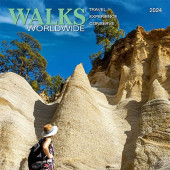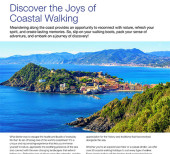The pilot announced we would soon be making our descent into Gran Canaria, and the serene blue seas started becoming punctuated by rocky outcrops. Was that Lanzarote? Perhaps. Or possibly Fuerteventura? To my left were the open oceans that would eventually lead to Morocco and Western Sahara. To my right, I could make out the fertile valleys and towering landscapes that would host me for the next few days.
 We met our driver and turned right out of the airport, heading to the north of the island, whilst our companions from our flight headed south to enjoy the coastal dunes and beaches that the island is more renowned for. We, however, would be immersing ourselves in the hidden delights found in the north, far away from any crowds to a charming village called Agaete, in what I would soon learn is the best part of Gran Canaria, known for nature and venturing off-the-beaten-track.
We met our driver and turned right out of the airport, heading to the north of the island, whilst our companions from our flight headed south to enjoy the coastal dunes and beaches that the island is more renowned for. We, however, would be immersing ourselves in the hidden delights found in the north, far away from any crowds to a charming village called Agaete, in what I would soon learn is the best part of Gran Canaria, known for nature and venturing off-the-beaten-track.
 Before I travelled, I researched which Canary Island is best for walking, and if, like me, you want to appreciate a wide diversity of landscapes and habitats from the trails, then a walking holiday in Gran Canaria is a fantastic option. With the UNESCO Biosphere Reserve central mountains, pine forest, rainforest, beaches, coastal dunes and cliffsides - some of the highest in the world, towering over a kilometre high - there is so much to enjoy as Gran Canaria continues to reveal its charm.
Before I travelled, I researched which Canary Island is best for walking, and if, like me, you want to appreciate a wide diversity of landscapes and habitats from the trails, then a walking holiday in Gran Canaria is a fantastic option. With the UNESCO Biosphere Reserve central mountains, pine forest, rainforest, beaches, coastal dunes and cliffsides - some of the highest in the world, towering over a kilometre high - there is so much to enjoy as Gran Canaria continues to reveal its charm.
 As we approached Agaete, I noticed the banana plantations and vineyards painting the landscape green, a testament to the island's tropical climate. In the village, whitewashed buildings typical of mainland Spain contrasted beautifully against the brownish-black of the mountains that seemingly dropped into the Atlantic Ocean. Locals were bathing in the natural salt pools below whilst hikers were returning from a day on the walking trails - and tomorrow, I would be treading in their footsteps.
As we approached Agaete, I noticed the banana plantations and vineyards painting the landscape green, a testament to the island's tropical climate. In the village, whitewashed buildings typical of mainland Spain contrasted beautifully against the brownish-black of the mountains that seemingly dropped into the Atlantic Ocean. Locals were bathing in the natural salt pools below whilst hikers were returning from a day on the walking trails - and tomorrow, I would be treading in their footsteps.
 Hiking along the path, it wasn't long before fragrant purple sage and pine forests made way to a vast open plain, with the island's second-highest peak, Pico de las Nieves, jutting out of the horizon. We craned our necks ever so slightly to the right, where Mount Teide - Spain's highest peak on the island of Tenerife - was floating above the clouds in all its splendour.
Hiking along the path, it wasn't long before fragrant purple sage and pine forests made way to a vast open plain, with the island's second-highest peak, Pico de las Nieves, jutting out of the horizon. We craned our necks ever so slightly to the right, where Mount Teide - Spain's highest peak on the island of Tenerife - was floating above the clouds in all its splendour.
 We continued walking through the forest, but this time our mind was set on locating the endemic Gran Canaria blue chaffinch. One of the rarest songbirds in the world, only 450 of these have been recorded on Gran Canaria, and we were in the prime area to view them. About 45 minutes into our walk and we were almost defeated. After all, it was such a rare species, and it does require a good amount of luck to spot one. We stopped at a water fountain the birds are known to frequent, and we tried our luck for the last time, but were unsuccessful. Regrettably, we boarded our transfer back to the hotel when our driver suggested stopping where we began our walk. We disembarked the bus, and to our surprise, we could hear its call. Looking up to the treetops, we could see African blue tit, but wait, what about that bird slightly further up? Could that be it? Our hard work had certainly paid off! We admired the glimpse of this rare bird, and as our acquaintance had shown such enthusiasm during the search, it made the moment even more magical.
We continued walking through the forest, but this time our mind was set on locating the endemic Gran Canaria blue chaffinch. One of the rarest songbirds in the world, only 450 of these have been recorded on Gran Canaria, and we were in the prime area to view them. About 45 minutes into our walk and we were almost defeated. After all, it was such a rare species, and it does require a good amount of luck to spot one. We stopped at a water fountain the birds are known to frequent, and we tried our luck for the last time, but were unsuccessful. Regrettably, we boarded our transfer back to the hotel when our driver suggested stopping where we began our walk. We disembarked the bus, and to our surprise, we could hear its call. Looking up to the treetops, we could see African blue tit, but wait, what about that bird slightly further up? Could that be it? Our hard work had certainly paid off! We admired the glimpse of this rare bird, and as our acquaintance had shown such enthusiasm during the search, it made the moment even more magical.
 In addition to the blue chaffinch, Gran Canaria is an excellent destination for nature lovers. During my short stay on the island, I filled my A5 pad with a long list of species we had seen, including the endemic Gran Canaria giant lizard, monarch and red admiral butterflies, Berthelot's pipit, Barbary falcon and the canary.
In addition to the blue chaffinch, Gran Canaria is an excellent destination for nature lovers. During my short stay on the island, I filled my A5 pad with a long list of species we had seen, including the endemic Gran Canaria giant lizard, monarch and red admiral butterflies, Berthelot's pipit, Barbary falcon and the canary.
 The following day, our walk took us to the edge of a caldera rim, with its volcanic history well-displayed through the rock layers. I heard the heart-warming tale of a gentleman, Agustino, who would walk down to the caldera every day until he sadly passed. I watched kestrels swoop down to catch their prey. I heard very little apart from the crunch underfoot. And I wished I could stay longer.
The following day, our walk took us to the edge of a caldera rim, with its volcanic history well-displayed through the rock layers. I heard the heart-warming tale of a gentleman, Agustino, who would walk down to the caldera every day until he sadly passed. I watched kestrels swoop down to catch their prey. I heard very little apart from the crunch underfoot. And I wished I could stay longer.
 My Gran Canaria walking experience left an indelible impression and was like nothing I had ever seen or experienced before. On our new itinerary, you can explore the quieter side of this island and reap the rewards of its astounding vistas.
My Gran Canaria walking experience left an indelible impression and was like nothing I had ever seen or experienced before. On our new itinerary, you can explore the quieter side of this island and reap the rewards of its astounding vistas.
 It's a great option for seasoned hikers, and of course, its location makes it an excellent winter sun walking holiday. I'm so excited that we're bringing hiking in Gran Canaria to Walks Worldwide, and I hope you feel as rejuvenated as I did after visiting.
It's a great option for seasoned hikers, and of course, its location makes it an excellent winter sun walking holiday. I'm so excited that we're bringing hiking in Gran Canaria to Walks Worldwide, and I hope you feel as rejuvenated as I did after visiting.
Find out more about our Gran Canaria hiking holiday, view all our walking holidays to the Canary Islands or to book, speak to our friendly team.











